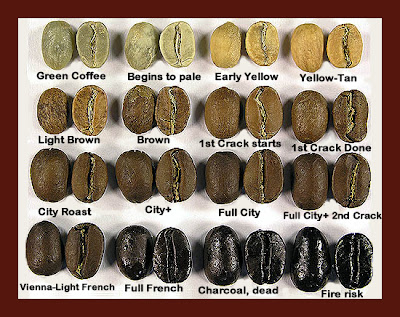Below are the meaning of the words that commonly used in coffee world :
Acidity, Acidy, Acid
Usually, the pleasant tartness of a fine coffee. Acidity, along with flavor, aroma, and body, is one of the principal categories used by professional tasters in cupping, or sensory evaluation of coffee. When not used to describe cup characteristics, the term acidity may refer to pH, or literal acidity, or to certain constituents present in coffee that ostensibly produce indigestion or nervousness in some individuals
Aroma
The fragrance produced by hot, freshly brewed coffee. Aroma, along with flavor, acidity, and body, is one of the principal categories used by professional tasters in cupping, or sensory evaluation of coffee.
Body
The sensation of heaviness, richness, or thickness and associated texture when one tastes coffee. Body, along with flavor, acidity, and aroma, is one of the principal categories used by professional tasters cupping, or sensory evaluation of coffee
Chaff
Flakes of the innermost skin of the coffee fruit (the silverskin) that remain clinging to the green bean after processing and float free during roasting
Cinnamon Roast
Also known as Light Roast and New England Roast. Coffee brought to a degree of roast of coffee lighter than the traditional American norm, and grain like in taste, with a sharp, almost sour acidity. This roast style is not a factor in specialty coffee.
City Roast
Also Light French Roast, Viennese Roast, Light Espresso Roast, High Roast, and Full-City Roast. Terms for coffee brought to degrees of roast somewhat darker than the traditional American norm, but lighter than the classic dark roast variously called espresso, French, or Italian. In the cup, full-city and associated roast styles are less acidy and smoother than the traditional American "medium" roast, but may display fewer of the distinctive taste characteristics of the original coffee. Among many newer American specialty roasters, roast styles once called full-city, Viennese, etc. may constitute the typical, "regular" roast of coffee.
Clean
Coffee cupping or tasting term describing a coffee sample that is free from flavor defects.
Coffee Oil, Coffeol
The volatile coffee essence developed in the bean during roasting
Complexity
A tasting term describing coffees whose taste sensations shift and layer pleasurably, and give the impression of depth and resonance.
Continental Roast
Also known as Espresso Roast, After-Dinner Roast, and European Roast. Terms for coffee brought to degrees of roast ranging from somewhat darker than the traditional American norm to dark brown. Acidity diminishes and a rich bitter-sweetness emerges. Among many newer American specialty roasters, roast styles once called by these names may in fact constitute the typical, "regular" roast of coffee
Cupping
Procedure used by professional tasters to perform sensory evaluation of samples of coffee beans. The beans are ground, water is poured over the grounds, and the liquid is tasted both hot and as it cools. The key evaluation characteristics are Aroma, Acidity, Body, and Flavor.
Dark French Roast
A roast of coffee almost black in color with a shiny surface, thin-bodied, and bittersweet in flavor, with an overlay of burned or charcoal-like tones.
Dark Roast
Vague term; may describe any roast of coffee darker than the traditional American norm.
Decaffeination Processes
Specialty coffees are decaffeinated in the green state, currently by one of four methods. The direct solvent method involves treating the beans with solvent, which selectively unites with the caffeine and is removed from the beans by steaming. The indirect solvent or solvent-water method involves soaking the green beans in hot water, removing the caffeine from the hot water by means of a solvent, and recombining the water with the beans, which are then dried. Both processes using solvents often are called European Process or Traditional Process. The water-only method, commonly known by the proprietary name Swiss Water ProcessTM, involves the same steps, but removes the caffeine from the water by allowing it to percolate through a bed of activated charcoal. In the carbon dioxide method, which is only beginning to be established in the specialty-coffee trade, the caffeine is stripped directly from the beans by a highly compressed semi-liquid form of carbon dioxide.
Defects, Flavor Defects
Unpleasant flavor characteristics caused by problems during picking, processing (fruit removal), drying, sorting, storage, or transportation. Common defects include: excess numbers of immature or under-ripe fruit (unselective picking); inadvertent fermentation (careless processing); fermentation combined with invasion by micro-organisms, causing moldy, hard, or rioy defects (careless or moisture-interrupted drying); and contact with excessive moisture after drying, causing musty or baggy defects (careless storage and transportation).
Degassing
A natural process in which recently roasted coffee releases carbon dioxide gas, temporarily protecting the coffee from the staling impact of oxygen.
Demitasse
"Half cup" in French; a half-size or three-ounce cup used primarily for espresso coffee.
Doppio
A double espresso or three to six ounces of straight espresso.
Drip Method
Brewing method that allows hot water to settle through a bed of ground coffee
Earthiness
Either a taste defect or a desirable exotic taste characteristic depending on who is doing the tasting and how intense the earthy taste in question is. Apparently earthiness is caused by literal contact of wet coffee with earth during drying. Indonesia coffees from Sumatra, Sulawesi and Timor are particularly prone to display earthy tones
French Roast, Heavy Roast, Spanish Roast
Terms for coffee brought to degrees of roast considerably darker than the American norm; may range in color from dark brown (see Espresso Roast) to nearly black (see Dark French Roast) and in flavor from rich and bittersweet to thin-bodied and burned.
Frothed Milk
Milk that is heated and frothed with a steam wand as an element in the espresso cuisine.
Full-City Roast, Light French Roast, Viennese Roast, Light Espresso Roast, City Roast, High Roast
Terms for coffee brought to degrees of roast somewhat darker than the traditional American norm, but lighter than the classic dark roast variously called espresso, French, or Italian. In the cup, full-city and associated roast styles are less acidy and smoother than the traditional American "medium" roast, but may display fewer of the distinctive taste characteristics of the original coffee. Among many newer American specialty roasters, roast styles once called full-city, Viennese, etc. may constitute the typical, "regular" roast of coffee
Hard Bean
Term often used to describe coffees grown at relatively high altitudes; in the same context, coffees grown at lower altitudes are often designated Soft Bean. The higher altitudes and lower temperatures produce a slower maturing fruit and a harder, less porous bean. Hard bean coffees usually make a more acidy and more flavorful cup than do soft bean coffees, although there are many exceptions to this generalization. The hard bean/soft bean distinction is used most frequently in evaluating coffees of Central America, where it figures in grade descriptions.
Heavy Roast
Also known as French Roast and Spanish Roast. Terms for coffee brought to degrees of roast considerably darker than the American norm; may range in color from dark brown (see Espresso Roast) to nearly black (see Dark French Roast) and in flavor from rich and bittersweet to thin-bodied and burned.
Latte, Caffè Latte
A serving of espresso combined with about three times as much hot milk topped with froth.
Macchiato
Either a serving of espresso "stained" or marked with a small quantity of hot frothed milk (espresso macchiato), or a moderately tall (about eight ounces) glass of hot frothed milk "stained" with espresso (latte macchiato). In North America, the term macchiato is more likely to describe the former (espresso stained with milk) than the latter (milk stained with espresso)
Silverskin
The thin, innermost skin of the coffee fruit. It clings to the dried coffee beans until it is either removed by polishing or floats free during roasting and becomes what roasters call chaff
Straight Coffee, Single-Origin Coffee
Unblended coffee from a single country, region, and crop.
Swiss Water Process
A trademarked decaffeination method that removes caffeine from coffee beans using hot water, steam, and activated charcoal rather than chemicals or solvents.
Tamper
In espresso brewing, the small, pestle-like device with a round, flat end used to distribute and compress the ground coffee inside the filter basket.





















